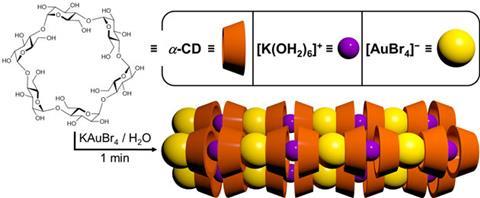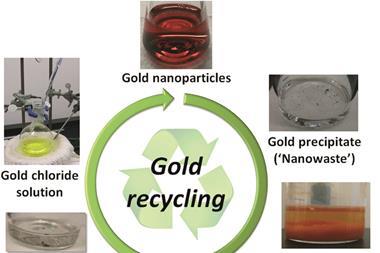The environmental legacy of salvaging gold from electronic waste can be dramatically cut using corn starch instead of cyanide

US researchers have discovered a way to selectively isolate and recover gold from raw materials, including alloys, using a simple sugar derived from corn starch. The work could offer a greener and cheaper alternative to conventional processes, which use cyanide and often result in environmental contamination.
Gold is typically recovered from mined ore and waste materials, including electronic waste, using highly poisonous cyanide to convert gold into a water-soluble coordination complex through a process known as leaching. But while effective, this process poses a risk to workers and the environment.
Fraser Stoddart and colleagues at Northwestern University in Evanston, Illinois, have done away with toxic reagents and instead use a-cyclodextrin – a polysaccharide found in corn starch. When mixed with a gold bromide salt in water, a precipitate quickly forms in solution. A reductant, such as sodium metabisulfite, can then be used in a final step to get the gold in its pure form.
The discovery happened by chance when Zhichang Liu in Stoddart’s lab mixed a solution of a-cyclodextrin with a dissolved gold salt. He was trying to make an extended, three-dimensional cubic structure suitable for storing gases and small molecules. However, needle structures rapidly formed instead.
X-ray crystallography revealed that the needles are composed of around 4000 nanowires bundled together thanks to supramolecular interactions. After further experiments with a-, ß- and ?-cyclodextrins and two different gold salts, the team found a-cyclodextrin and potassium tetrabromoaurate (KAuBr4) to be the best combination for the rapid formation of the needles.
‘We are fairly confident that this is a big leap forward in terms of being very different from any of the much more toxic methods that rely on cyanide to isolate gold,’ says Stoddart. ‘We don’t know of anything that is close to approaching this in terms of being environmentally benign and we think it could easily be increased in its scale.’
‘Any way to reduce the reliance on cyanide in gold extraction is certainly going to be very attractive for both environmental and societal reasons,’ says John Provis, a chemical engineer at the University of Sheffield, UK. ‘The most appealing points are the ability to recover the gold with a fairly simple separation step, and its high selectivity for gold over platinum and palladium – these are both common challenges in halide-based gold processes.’
However, John Monhemius at Imperial College, London, UK, thinks any practical applications will be limited to the treatment of recycled scrap containing gold or in the refining of gold doré, an alloy of gold and silver, produced at gold mines. ‘It is most unlikely that this new chemistry will have any impact on the long-established use of cyanide at gold mines worldwide for the recovery of gold from primary ores,’ he says. ‘It is a new precipitation method, not a new dissolution method and therefore is not applicable to leaching gold ores.’







No comments yet